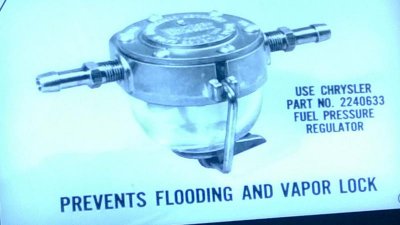[we pressure tested the fuel and we are getting 7-8 psi consistently. Thanks for the idea though. We do appreciate it.
QUOTE=WP29440SE;910098389]how do you know its actually vapor lock and not weak fuel pressure or flooding?[/QUOTE]
- - - Updated - - -
It is fresh fuel and we are also using the no ethanol gas.
Stupid question, but how old is the gas in your tank? Winter blend gas will always vapor lock in the summer. Lots of people fill their cars before putting away.
- - - Updated - - -
It appears we are getting fuel in the carb - we did worked the throttle with the engine off and it is getting fuel. So here is our thought: could it be the distributor causing an electrical issue that just gives the appearance of a vapor lock issue? The current distributor is a mopar performance and was put on when we rebuilt the engine 3 years ago. Should we consider an MSD or would we be wasting 450.00?
QUOTE=coloradodave;910098855]It's all good. My remark was solely about: Performance verses 1/4" fuel line. Those two things don't go together unless you're working on a VW. Also, since vapor lock occurs when liquid changes to vapor, due to heat, I am confused as to how a pressure regulator like the one above can help. Flooding from too much pressure, sure. A regulator with a return line, sure. Below is from Wikipedia. They actually got it right! Easy to check if that is the problem, as somebody said. When motor quits, take air filter off and work the throttle. If no gas shoots in from the squirters, you may have vapor lock! BTW, MOTOR OFF...
From Wikipedia, the free encyclopedia:
"Vapor lock is a problem that mostly affects gasoline-fueled internal combustion engines.
It occurs when the liquid fuel changes state from liquid to gas while still in the fuel delivery system. This disrupts the operation of the fuel pump, causing loss of feed pressure to the carburetor or fuel injection system, resulting in transient loss of power or complete stalling. Restarting the engine from this state may be difficult.
The fuel can vaporize due to being heated by the engine, by the local climate or due to a lower boiling point at high altitude. In regions where higher volatility fuels are used during the winter to improve the starting of the engine, the use of "winter" fuels during the summer can cause vapor lock to occur more readily."[/QUOTE]
- - - Updated - - -
Been busy trying all the suggestions you guys have posted.
- - - Updated - - -
Well since you are asking, we did get stranded in the Wally World parking lot... But eventually made it back.

















